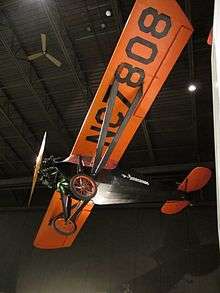Monocoupe Aircraft
Monocoupe Aircraft is a term that refers to a line of small light airplanes, and the various companies that produced them (late 1920s to the late 1990s, intermittently).[1]
In the late 1920s, Monocoupes were famous for introducing relatively inexpensive, compact, affordable, convenient, sporty, speedy and efficient flying to the light plane market. In an era of large, expensive, open-cockpit biplanes, the Monocoupe was the first popular, compact, enclosed-cabin, two-seat, light plane in the United States.[1]
Light and clean, by comparison to other aircraft of the time, and affordable to own, the Monocoupe soon became popular for racing, and was soon one of the most successful brand of airplanes in America's popular air races of the 1920s and 1930s.[1]
Throughout the 1930s, and into the 1950s, the Monocoupes evolved through a series of increasingly powerful models, and remained popular. The design was briefly revived and produced in the 1990s by Aviat Aircraft.[1]
Company History
Central States Airplane Company was established in 1927 to build Don A. Luscombe's Monocoupe.[2] In January 1928, the company became the Mono Aircraft Division of Velie Motor Corporation.
Following Willard Velie's death in March 1929, the Velie interests were sold to Allied Aviation Industries, a holding company. By May, these interests were divided into two separate companies: the Lambert Aircraft Engine Corporation and the Mono Aircraft Company of Moline, IL. Both companies passed into receivership in 1931, reemerging in 1932 as the Lambert Engine and Machine Company and the Monocoupe Corporation In July 1934 the two companies joined under the newly formed Lambert Aircraft Corporation with Monocoupe continuing to operate under its own name.
In 1940 the company was dissolved and its assets passed to the Monocoupe Aeroplane and Engine Corporation (transferring operations to Orlando, FL).[3]
In September 1941, Monocoupe acquired the Bristol Aircraft Corporation of Bristol, Virginia and its Canadian subsidiary Bristol Aircraft Products Ltd. The operations of these three companies were combined under the Universal Molded Products Corporation with Monocoupe forming a separate division of the company. Aircraft production halted during World War II, resuming briefly in 1948-1950 under the name Monocoupe Airplane and Engine Corporation In 1955, the corporate assets were acquired by a West Virginia aviation group, which reorganized the company as Monocoupe Aircraft of Florida, Inc. and transferred operations to Melbourne, Florida.[3]
The company name re-emerged as Mono Aircraft, Inc. briefly in 1992, in Cheney, Kansas, with the Monocoupe type certificate acquired by Saturn Aircraft & Engineering, Oxnard, California. Aviat Aircraft developed a modernized variation of the Monocoupe 110 as the 200-horsepower 110 Special, and sold a few with modern 200-horspepower engines. [1] [4]
Aircraft Models

- Meteor
- Monocoach
- Model H & Model H Special
- Model 201
- Model 275
- Monocoupe
- Model 5
- Monocoupe Model 22
- Monocoupe Model 70
- Model 90
- Model 110 Special
- Monocoupe Model 113
- Monocoupe Model 125
- Monocoupe Model D-145
- Monoprep
- Model 90
- Model 218
- Monosport
- Model 1 also Monosport 249
- Model 2
- Model D (See also: Culver Dart-G)
- Model G & Model G Deluxe
- Model 1344
References
- 1 2 3 4 5 Richard Harris, "Monocoupe: Speed for the Common Man", AAHS Journal, Vol. 56, No. 4 (Winter 2011), American Aviation Historical Society
- ↑ Donald M. Pattillo. A History in the Making: 80 Turbulent Years in the American General Aviation Industry. p. 20.
- 1 2 Bell, 2002. p. 207.
- ↑ aerofiles.com
- Bell, Dana ed. The Smithsonian National Air and Space Museum Directory of Airplanes their Designers and Manufacturers. Stackpole Books Mechanicsburg, PA, 2002. ISBN 1-85367-490-7.